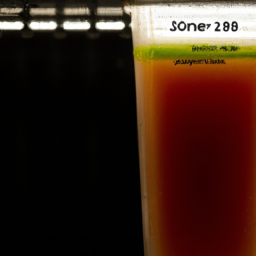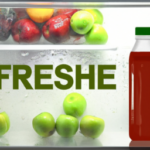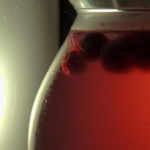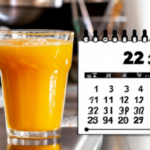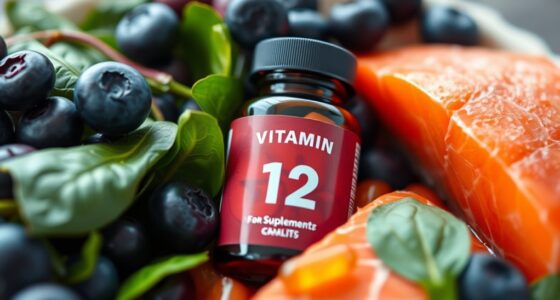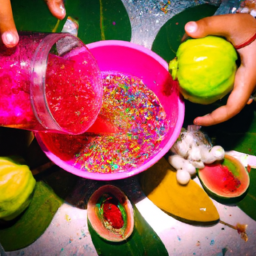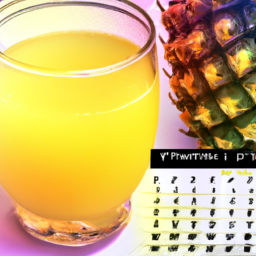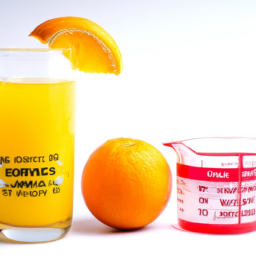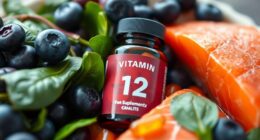As a lover of enjoying a refreshing glass of juice, I often think about the expiration date of store-bought juice. When we buy juice in bulk and keep it in the fridge for quite some time – anywhere from a few days to a few weeks, it makes me wonder: How long can we actually keep it before it goes bad and becomes undrinkable? Curious to find out? Keep reading to discover the surprising truth!
In this article, I will share my knowledge and experience on the shelf life of different types of store-bought juice and the proper storage techniques to help you make the most of your juice purchase. It’s important to note that the shelf life of store-bought juice varies depending on the type of juice and the storage conditions. Some juices, like citrus juices, have a shorter shelf life than others, while some may last longer if stored properly.
Knowing the shelf life of different types of juice can help you plan your grocery shopping and prevent waste. In the following sections, I will discuss the shelf life of various types of juice and the signs to look out for when juice has gone bad. So, let’s dive in and explore the world of juice shelf life!
Key Takeaways
- Different types of store-bought juice have varying shelf lives, with citrus juices having a shorter shelf life than others.
- Proper storage techniques, such as refrigeration and airtight containers, can help extend the shelf life of juice and preserve its freshness and quality.
- Signs of spoilage in juice include a sour or off smell, a change in color or texture, and the presence of mold or bubbles.
- Expired juice can be used for non-food purposes or in cooking/baking, but caution should be exercised as it comes with some risk.
Understanding the Shelf Life of Store Bought Juice
You’re probably wondering how long store bought juice lasts in the fridge – well, it really depends on the type of juice and the expiration date. Understanding the best before vs. expiry dates is crucial in determining how long you can store the juice.
Best before dates indicate the time frame for which the juice is expected to retain its best quality, while expiry dates indicate the time frame in which the juice is safe to consume. It’s important to note that once a juice has passed its expiry date, it should be discarded immediately.
In addition to understanding the dates, how you store store bought juice plays a critical role in determining its shelf life. Proper storage is essential in preserving the freshness and quality of the juice. Always keep store bought juice in the fridge, even before opening, and make sure it’s sealed tightly.
Once opened, consume the juice within 7 days, regardless of the best before or expiry date. With citrus juices, it’s best to consume them within 3-5 days of opening as they tend to spoil quicker than other types of juice.
Citrus Juices
If you’ve ever wondered about the lifespan of citrus juices in the refrigerator, it’s worth noting that on average, they can stay fresh for up to a week. However, this may vary depending on the type of citrus juice and how it was processed.
To extend the shelf life of your citrus juice, you can try some juice preservation techniques such as freezing or adding preservatives.
Aside from its refreshing taste, citrus juice is packed with health benefits like vitamin C, antioxidants, and minerals that help boost the immune system and promote healthy skin. It’s also low in calories, making it a great option for those who are watching their weight.
Moving on to apple juice, it’s important to know that its shelf life is different from citrus juices.
Apple Juice
I’ve always been a fan of apple juice, and one thing I’ve noticed is that it seems to last longer than other juices in the fridge. After doing some research, I’ve discovered that this is because of the natural acidity in apples, which helps to preserve the juice.
However, it’s important to know how to tell if your apple juice has gone bad, as even with its longer shelf life, it can still spoil.
Why Apple Juice Lasts Longer
Apple juice lasts longer in the fridge because it undergoes a pasteurization process that destroys harmful bacteria and enzymes. This process involves heating the juice to a high temperature for a short period of time, which not only extends its shelf life but also preserves its flavor and nutritional value.
Factors affecting juice preservation include the type of fruit, the method of extraction, and the packaging used. For instance, freshly squeezed juice tends to spoil faster than commercially processed juice because it contains more natural enzymes and microorganisms.
Compared to other fruit juices, apple juice has a longer shelf life due to its low pH level and high concentration of natural preservatives, such as malic acid and antioxidants. These compounds inhibit the growth of bacteria and fungi that can cause spoilage, making apple juice one of the most stable and widely consumed juices worldwide.
However, even with pasteurization and proper storage, apple juice can still go bad if exposed to air, light, heat, or contamination. Therefore, it’s essential to know how to tell if apple juice has gone bad, which we’ll discuss in the next section.
How to Tell If Apple Juice Has Gone Bad
Determining whether apple juice has spoiled requires a keen eye for changes in color, smell, and taste. Signs of spoilage may include a cloudy appearance, a sour or rancid smell, and a bitter or off taste. Additionally, the juice may have visible mold or sediment at the bottom of the container.
To ensure that apple juice is still safe to drink, it’s important to check the best before date on the packaging. If the juice has passed its expiration date, it’s best to discard it. When checking the best before date, it’s important to keep in mind that the date isn’t a guarantee of freshness.
Some juices may spoil before the best before date, while others may remain safe to drink for several days or even weeks past the date. To further ensure the safety of the juice, it’s recommended to store it in the refrigerator at all times.
By following these guidelines, you can be sure that your apple juice is fresh and safe to drink. Now, let’s move on to discussing grape juice.
Grape Juice
I’ve had my fair share of grape juice over the years, and I’ve learned a thing or two about its shelf life.
Generally, unopened grape juice can last up to a year in the pantry, but once opened, it needs to be refrigerated and consumed within 7-10 days.
To tell if grape juice has gone bad, look for signs of mold, a sour smell, or a strange taste.
Shelf Life of Grape Juice
You can enjoy a refreshing glass of grape juice for up to a week in the fridge after opening it. However, there are ways to extend the shelf life of grape juice and keep it fresh for a longer time.
Here are some tips on how to properly store grape juice:
- Keep it refrigerated: The best way to store grape juice is to keep it in the fridge at all times. This will slow down the growth of bacteria and mold, which can spoil the juice quickly.
- Use an airtight container: Once you open the bottle or carton of grape juice, transfer it to an airtight container. This will help to prevent air from getting in and oxidizing the juice, which can cause it to spoil faster.
By following these simple steps, you can extend the shelf life of your grape juice and enjoy it for a longer period of time.
But how do you tell if your grape juice has gone bad? Let’s find out in the next section.
How to Tell If Grape Juice Has Gone Bad
To ensure that your grape juice is safe to drink, it’s important to pay attention to its appearance, smell, and taste. Signs of spoilage may include a cloudy or murky appearance, an off smell, or a sour taste. If you notice any of these signs, it’s best to discard the grape juice and not consume it.
Grape juice, like any other food or beverage, can become contaminated with bacteria or other microorganisms. Common contaminants in grape juice may include mold, yeast, and bacteria such as E. coli or Salmonella.
To prevent contamination, it’s important to store grape juice properly, keep it refrigerated, and consume it before its expiration date. By following these guidelines, you can ensure that your grape juice stays safe to drink and free from spoilage or contamination.
Moving forward, let’s take a look at how long cranberry juice can last in the fridge.
Cranberry Juice
Cranberry juice typically lasts for up to two weeks in the fridge, but it’s important to check the expiration date on the bottle. As someone who enjoys cranberry juice cocktails and understands the health benefits of cranberry juice, I always make sure to keep an eye on the expiration date to ensure that I’m drinking fresh juice.
To help you better understand how long cranberry juice can last in the fridge, here’s a table that outlines the typical shelf life of different types of cranberry juice:
| Type of Cranberry Juice | Unopened | Opened |
|---|---|---|
| Regular Cranberry Juice | 9-12 months | 7-10 days |
| Cranberry Juice Cocktail | 9-12 months | 7-10 days |
| Cranberry Juice Blend | 9-12 months | 7-10 days |
| Fresh Cranberry Juice | 2-3 weeks | 5-7 days |
As you can see, unopened cranberry juice can last up to 9-12 months, while opened juice typically lasts for around a week. Fresh cranberry juice has a shorter shelf life, but it’s important to note that it’s also healthier and more nutritious than juice that has been sitting on the shelf for months. Now, let’s move on to discussing the shelf life of other types of juice.
Other Types of Juice
I’ve had my fair share of different types of juice and I’ve learned a thing or two about their shelf life.
Pineapple juice, for instance, can last up to a week in the fridge if it’s unopened. But once opened, it should be consumed within three to five days.
Tomato juice, on the other hand, can last up to two weeks in the fridge after opening.
And if you’re a fan of vegetable juice, it’s best to consume it within three to five days after opening to ensure its freshness.
Shelf Life of Pineapple Juice
You think you can keep that pineapple juice in the fridge for a while, huh? Well, surprise! It’s not going to last as long as you hope. Pineapple juice typically has a shelf life of 5-7 days when stored in the refrigerator. However, there are ways to preserve pineapple juice for a longer period of time. One way is to freeze it in an airtight container or ice cube tray and thaw as needed. Another method is to add lemon juice or citric acid to the juice to increase its acidity, which can help prevent spoilage.
Drinking pineapple juice has many benefits, including aiding in digestion, reducing inflammation, and boosting immunity. However, it’s important to consume it within its shelf life to reap these benefits. If you’re planning to buy pineapple juice in bulk, consider these preservation methods to extend its shelf life. Up next, let’s talk about the shelf life of tomato juice.
Shelf Life of Tomato Juice
If you’re a fan of tomato juice, you’ll be pleased to know that it typically has a shelf life of about 6-8 months when stored properly. As a juice that’s rich in vitamins and antioxidants, tomato juice can offer a range of health benefits, including improved digestion, lower cholesterol levels, and reduced risk of heart disease.
To ensure that your tomato juice stays fresh for as long as possible, it’s important to store it in the refrigerator at all times, keeping it away from direct sunlight and heat sources.
When it comes to consuming tomato juice, there are a few different approaches you can take. Some people prefer to drink it straight, while others like to mix it with other juices or add a pinch of salt and pepper for extra flavor. Tomato juice can also be used as a base for cocktails or as an ingredient in recipes such as gazpacho or tomato soup.
Whatever your preference may be, the key is to choose a high-quality tomato juice that’s free from added sugars and preservatives, and to enjoy it in moderation as part of a balanced diet.
Moving on to the shelf life of vegetable juice, it’s important to note that different types of vegetable juices may have varying expiration dates depending on their ingredients.
Shelf Life of Vegetable Juice
Vegetable juice varies in vitality depending on its vegetable ingredients. Some vegetables have higher nutritional benefits than others, and juicing methods can also affect the quality of the juice. For example, cold-pressed juice is believed to retain more nutrients than juice made with other methods. However, regardless of the juicing method or vegetable ingredients used, it is important to know the shelf life of store-bought vegetable juice.
To highlight the importance of proper storage techniques for vegetable juice, consider this table:
| Type of Vegetable Juice | Refrigerator Shelf Life |
|---|---|
| Carrot Juice | 4-9 Days |
| Beet Juice | 3-7 Days |
| Green Juice (Kale, Spinach, etc.) | 1-3 Days |
This table shows that while some vegetable juices can last up to 9 days in the refrigerator, others can spoil in as little as 1 day. It is important to consume vegetable juice within its recommended shelf life to ensure that it is safe to drink and still contains its nutritional benefits.
Proper storage techniques, such as storing the juice in an airtight container and keeping it at a consistent temperature, can help extend the shelf life of vegetable juice. By taking these precautions, you can ensure that your vegetable juice stays fresh and nutritious for as long as possible.
Proper Storage Techniques
To keep your store-bought juice fresh for longer, make sure to store it in the refrigerator as soon as possible after opening. Storing juice properly is key to preventing spoilage and maintaining its freshness.
Here are three tips for storing your juice properly:
-
Keep the juice in its original container. The packaging is designed to keep the juice fresh and prevent exposure to air and light.
-
Store the juice in the coldest part of the fridge, typically the back of the bottom shelf. This helps maintain a consistent temperature, which is important for preventing spoilage.
-
Keep the juice away from strong-smelling foods such as onions and garlic. These foods can transfer their odor to the juice and affect its taste.
Now that you know how to store your juice properly, it’s important to know how to tell if it has gone bad.
How to Tell If Juice Has Gone Bad
Now that we know how to properly store juice in the fridge, let’s talk about how to tell if it’s gone bad. It’s important to note that common contaminants in juice include bacteria, mold, and yeast, which can cause spoilage. This is why it’s crucial to always check your juice before consuming it, especially if it has been sitting in the fridge for a while.
So, how can you tell if your juice has gone bad? Signs of spoilage include a sour or off smell, a change in color or texture, and the presence of mold or bubbles. If your juice has any of these characteristics, it’s best to err on the side of caution and throw it out. It’s always better to be safe than sorry when it comes to consuming potentially harmful substances.
As for what to do with expired juice, there are a few options. One is to use it for non-food purposes, such as cleaning or gardening. Another is to use it in cooking or baking, as the heat will kill any bacteria or mold. However, it’s important to note that using expired juice in any capacity comes with some risk, so it’s best to use your judgment and proceed with caution.
Using Expired Juice
If you happen to come across expired juice, you might want to consider using it for non-food purposes or in cooking, although it’s important to be cautious of the risks associated with consuming expired products. Here are some creative recipes for expired juice that I’ve tried and enjoyed:
-
Use it as a marinade for meat or vegetables. The acid in the juice can help tenderize the meat and add a flavorful twist to your dish.
-
Mix it into a smoothie or cocktail. Just make sure to taste it first and adjust the sweetness level if necessary.
-
Use it to make popsicles or ice cubes. This is a fun way to use up the juice and create a refreshing treat.
-
Add it to your bath for a relaxing and rejuvenating experience. The antioxidants in the juice can help nourish and hydrate your skin.
-
Use it as a natural dye for fabrics or paper. This can be a fun craft project and an eco-friendly alternative to commercial dyes.
Overall, using expired juice can be a great way to reduce waste and explore your creativity. Just make sure to use your best judgment and be mindful of any potential health risks.
Frequently Asked Questions
Can store bought juice be frozen to extend its shelf life?
Yes, store bought juice can be frozen to extend its shelf life. The freezing method is simple and effective. When thawing, it is recommended to leave the juice in the fridge overnight for best results.
Is it safe to drink juice past its expiration date?
Drinking juice past its expiration date can pose health risks. Factors affecting expiration include processing methods, packaging, and storage conditions. As an experienced consumer, I always check the expiration date before consuming any juice.
Does the type of container the juice is stored in affect its shelf life?
Storage tips and container options can greatly affect the shelf life of juice. Glass or plastic containers with airtight lids are best for preserving freshness. Avoid storing in direct sunlight or warm temperatures.
Can adding fresh fruit to store bought juice increase its shelf life?
"Adding fresh fruit to store bought juice not only enhances its flavor, but can also increase its shelf life. Experiment with flavor combinations like strawberry and orange or cucumber and mint for a refreshing twist." ‘Additionally, incorporating fruits into your juice can provide added nutrients and vitamins.’
Does juicing your own fruits and vegetables have a longer shelf life than store bought juice?
Juicing your own fruits and vegetables has many benefits beyond a longer shelf life than store bought juice. It retains the maximum nutritional value and offers a personalized flavor profile.
Conclusion
So, there you have it – the shelf life of store bought juice varies depending on the type of juice. Citrus juices last the shortest, while cranberry juice and other types can last up to a year.
Properly storing your juice in the fridge and checking for signs of spoilage can help ensure that you’re consuming fresh, safe juice.
In the end, it’s always better to be safe than sorry. If you’re unsure about the freshness of your juice, it’s best to dispose of it rather than risk getting sick. As the old saying goes, "better safe than sorry,"and this definitely applies when it comes to consuming perishable food and drinks.
Ilana has been a vegan for over 10 years. She originally made the switch for health reasons, but soon found herself becoming more and more passionate about the ethical and environmental implications of a vegan lifestyle. Ilana is the author of The Graceful Kitchen, a blog all about veganism. She loves to cook up delicious and nutritious vegan meals, and share her recipes with others who are interested in leading a cruelty-free life. Ilana is also a strong advocate for using whole foods as the foundation of a healthy diet, and believes that going vegan is one of the best ways to achieve this.
